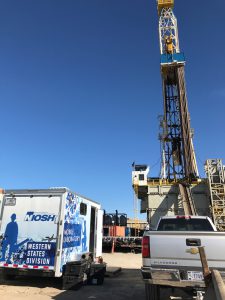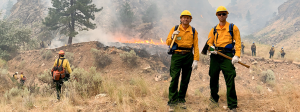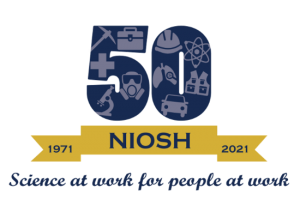NIOSH in Denver
Posted on byNIOSH has had a presence in Denver since the early 1970s shortly after NIOSH was created. While the name of the office and the functions have changed over time, a commitment to improving occupational health and safety conditions for those working in the Western United States has remained constant. In 2015, the Denver Office became part of the new NIOSH Western States Division. Together with the NIOSH Alaska Office and the Spokane Research Laboratory, the staff in the Denver Office work to address the high fatality rates and worker occupational health risks in many of the Western states.
Background
Originally, the NIOSH Denver Office was one of ten NIOSH Regional Offices (one in each Federal Region) with a broad mission of representing all NIOSH functions in the region. In the 1980s, the number of Regional Offices were reduced to three (Boston, Atlanta, Denver) and the Denver Office mission was narrowed to conducting Health Hazard Evaluations (HHEs). In 1995, the NIOSH Denver Office relocated from the HHS Regional Office in Denver to the Denver Federal Center in Lakewood, Colorado.
In the early 2000s there was considerable interest in expanding the Denver Office to have a more robust presence, in part due to the following considerations:
- Census data consistently demonstrated rapid growth and population shifts to the Western U.S.
- Nine of the ten fastest growing states in the U.S. since 1990 were in the West.
- Overall, the occupational fatality rate for the period 1992-2006 was 11% higher in the 19 Western states compared to the rest of the United States.
- The U.S. states with the highest fatality rates for occupational fatality during 1980–2000 were Alaska (20.9 per 100,000 workers), Wyoming (14.9), Montana (11.1), and Idaho (9.7). The greatest numbers of fatal occupational injuries during that time period occurred in California (12,221) and Texas (11,635).
- Industries with the highest rates of injury predominated in the West: mining, oil and gas exploration and extraction, agriculture, and construction. Issues specific to the West (long travel distances, climate, temperature, and elevation extremes) and emerging issues exacerbated by environmental concerns, such as water shortages, wildfires presented unique challenges and hazards.
- Except for a NIOSH laboratory in Spokane, Washington that was dedicated to mining safety and health, Denver was the only Western NIOSH office in the continental U.S.
In 2008, the office was realigned to focus on a broader array of occupational safety and health issues unique to the Western U.S. The role of the office was expanded to identify and respond to priority Western occupational safety and health issues, serve as a “local” NIOSH presence in the Western U.S., and coordinate activities with other NIOSH assets throughout the U.S. (Alaska Office, Spokane Research Laboratory, and NIOSH offices in Pittsburgh, Morgantown and Cincinnati). This role was further expanded when the Denver Office became part of the Western States Division in 2015. Additionally, throughout the years, Denver Office staff have responded to and held leadership roles in numerous national and international emergencies.
The Denver Office contributes substantially to the following research priorities of the NIOSH Western States Division.
Oil and Gas Extraction
Early publications by NIOSH found the fatality rate for the onshore oil and gas extraction (OGE) industry was seven times higher than that of general industry. Oil and gas workers face difficult and unique conditions, including extended work shifts, long commutes to remote sites, and considerable use of heavy equipment. Significant risks also exist for exposures to chemicals including hydrogen sulfide, hydrocarbons, diesel particulate matter, and respirable crystalline silica. Denver-based industrial hygiene field work and research identified extremely high worker exposures to respirable crystalline silica during hydraulic fracturing activities and was integral in identifying worker fatalities associated with hydrocarbon exposures during tank gauging operations. Current research areas include motor vehicle safety (seatbelt use, in-vehicle technologies, fatigue), noise and ototoxic exposures, and enhanced surveillance of injuries and illness in this workforce. Visit the Oil and Gas Extraction webpage for more research and information.

In 2013, NIOSH staff from the Denver Office worked with OGE industry experts and the Rocky Mountain Education Center at Red Rocks Community College to develop curriculum for the OSHA 5810 course. The course, which is still offered today helps workers anticipate, recognize, evaluate and control hazards common to the onshore oil and gas exploration and production industry. This includes work sites associated with the onshore exploration and production oil and gas industry including, but not limited to construction, drilling, completion, well servicing, production, product gathering and processing, and product transmission.
A NIOSH mobile laboratory was purchased and configured specifically to expand industrial hygiene exposure assessment capabilities in the field for oil and gas extraction research. The lab (which can be towed behind a truck) allows NIOSH researchers to use laboratory-grade instruments in the field for rapid analysis of industrial hygiene samples. Having this lab located in Denver is logistically convenient to access many oil and gas workplaces.
Wildland Fire Fighting
Over 400 on-duty wildland firefighter (WFF) fatalities occurred between 2000-2019, based on data compiled in the NIOSH Wildland Firefighter On-Duty Death Surveillance System. The Denver Office is the home to the Wildland Fire Fighting program at NIOSH. Common hazards faced on the fire line can include burnovers/entrapments, heat-related illnesses and injuries, smoke inhalation, vehicle-related injuries (including aircraft), slips, trips, and falls, and others. In addition, due to prolonged intense physical exertion, WFFs are at risk for sudden cardiac deaths and rhabdomyolsis.
NIOSH offers resources for fire departments, firefighters, and partner organizations to prevent on-duty injuries, illnesses, and deaths from hazards and exposures associated with fighting wildfires.

In 2018, NIOSH, in partnership with the United States Forest Service (USFS) and the United States Department of the Interior (DOI), started the Wildland Firefighter Exposure and Health Effects (WFFEHE) study. Over 50 researchers from NIOSH and the USFS are following a group of federally-employed wildland firefighters (WFFs) over three fire seasons. The purpose of this study is to understand better the potential chemical and physical hazards associated with wildland firefighting and how these exposures affect WFFs’ health, especially after multiple fire seasons. This study will assess effects on WFFs’ lungs, heart, kidneys, and hearing.
In addition, occupational factors that increase stress on the body such as arduous work, long work shifts, and environmental exposures (including wildfire smoke) may contribute to increased susceptibility and potentially more severe illness for COVID-19. In 2021, NIOSH researchers examined how exposure to wildfire smoke could contribute to this risk. See related blog.
American Indians and Alaska Natives (AI/AN) Workers
American Indian and Alaska Native tribes (AI/AN) are sovereign nations that maintain a government-to- government relationship with the United States. As of 2018, there were 567 federally recognized tribes throughout the United States. AI/AN workers account for 2.7 million or 1.8% of the total U.S. workforce. These workers are employed in a wide variety of occupations with the highest numbers in office and administrative support, sales and related occupations, management, transportation and material moving, and food preparation and serving. In 2013, NIOSH launched an initiative to partner with AI/AN communities, organizations, and other stakeholders to identify priority issues, conduct outreach, and determine how NIOSH could best provide occupational safety and health support to tribal communities. The main goal of the initiative is to build and strengthen tribal occupational safety and health capacity to ensure workers make it home safely and healthily to their families and communities every day. All activities are coordinated with the U.S. Centers for Disease Control and Prevention’s Center for State, Tribal, Local, and Territorial Support (CSTLTS).
- Working collaboratively with our AI/AN partners, NIOSH helped develop the American Indian and Alaska Native (Al/AN) Worker Safety and Health Strategic Plan, 2022-2031.
- With funding from NIOSH, the Southwest Center for Agricultural Health, Injury Prevention and Education, developed an intervention targeted at pesticide safety and education for handling chemicals, understanding their uses, and interpreting labels. “Model Farmers”—those viewed as trusted community members—were trained by agricultural extension agents to provide hands-on learning experiences to community farmers. Among the successes: the use of locked storage practices for pesticides increased from 60% to 94%; the use of safety equipment increased from 43% to 100%; the use of application equipment increased from 23% to 60%. See: A Story of Impact: Use of Model Farmers Proves Effective in Increasing Safety Practices Among Navajo Agricultural Workers
- Those who work with bison face unique risks. Bison are the largest land mammals in North America, weighing in at about 1,000-2,000 pounds. NIOSH funded research from the Central States Center for Agricultural Safety and Health to better understand hazards and risks to worker health and safety while handling bison under contemporary reservation field conditions and implement intervention strategies. See related blog.
Western States Occupational Network
In 2007, in an example of true partnership, NIOSH Denver staff worked with partners throughout the region to create the Western States Occupational Network (WestON). WestON is a network of state-based occupational health epidemiologists and administrators from 19 Western states, NIOSH and OSHA federal partners, NIOSH Education and Research Center (ERC) professionals, and NIOSH agricultural center professionals. This network was established to build state-based occupational safety and health (OSH) capacity in the Western states and bring together more experienced states with those that are just beginning to consider developing an occupational epidemiology program. The inaugural WestON meeting was held in Denver, CO in 2008 and continues to convene every year. The annual WestON meeting provides a unique opportunity for this group to meet and address common workplace safety and health issues and to further develop collaborations and partnerships to enhance state-based epidemiology, surveillance, and prevention of work-related injuries and illnesses.
Cannabis
In 2012, Colorado and Washington State became the first states in the country to legalize adult recreational use of cannabis. Recognized as an emerging industry in the West, NIOSH staff began initial involvement in cannabis-related occupational health activities. These included working with colleagues at the Colorado Department of Public Health and Environment to create the state’s Guide to Worker Safety and Health in the Marijuana Industry, one of the first guidance documents of its type for the industry. Staff also collaborated with the OSHA Rocky Mountain Education Center at Red Rocks Community College to initiate a 10-hour training course focused on the hazards found in various aspects of the Colorado cannabis industry. Staff participated on the Centers for Disease Control and Prevention’s (CDC’s) Cannabis Workgroup, providing worker health and safety input on CDC’s Cannabis Strategy, as well as supported NIOSH’s Health Hazard Evaluation (HHE) program in its investigations of cannabis-related occupational health hazards. Most recently, staff are exploring the factors that may contribute to allergic symptoms and sensitization experienced by workers in cannabis growing operations in the Denver metropolitan area. This pilot study will build on previous NIOSH HHEs to inform the development of worker safety and health programs aimed at protecting the increasing numbers of workers in the cannabis industry.
As NIOSH celebrates its 50th anniversary, the Denver Office looks forward to many more years of research and prevention to protect worker health and safety in the West and throughout the U.S.
David L. Caruso is Coordinator of the NIOSH Oil & Gas Safety & Health Program
This blog is part of a series for the NIOSH 50th Anniversary. Stay up to date on how we’re celebrating NIOSH’s 50th Anniversary on our website.
Posted on by

